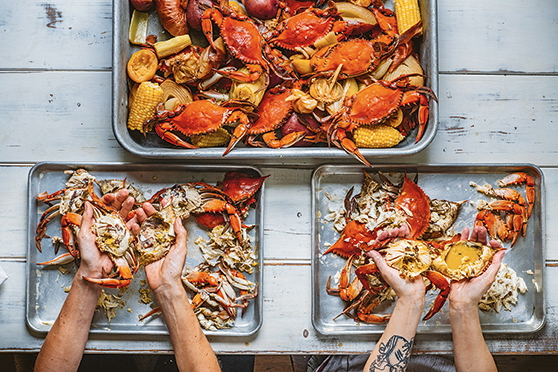Get Premium access to all the latest content online
Subscribe and view full print editions online... Subscribe
Serves 1-2 (dependant on recipes) Starters and mains
There's something delightfully nostalgic about crab. Like shell-suited phantoms from the rock pools of your childhood, they are as versatile as they are tasty. A quick meal, however, they are not. From catching them to prying out their succulent meat, a crab feast is a primal act with no shortcuts – making it one of life’s great slow experiences. Methods haven’t modernised much. Fishermen bait their pots, leave them overnight and return the next day to pack their catch and sell them to fishmongers. If you’re lucky, you may be able to buy them, still dripping, on the harbour front. Wherever you source yours, to devour crabmeat laced with lemon is to taste sunlight, summer and the sea – whether you have sand between your toes or city pavements beneath your shoes.
Hand-picking cooked crab isn’t easy and, if it’s not done well, can result in lots of the meat being wasted. It takes time, practice and skill, but this step-by-step guide will ensure that you’re getting crabmeat with the best flavour and its integrity intact
Crabs are an incredible species. Soft-shell crabs are blue crabs that have recently shed in a process known as molting, which happens repeatedly throughout their lifetime. A white line on the paddle fin indicates that the crab has about two weeks before molting, a pink line suggests one week and a red line means it could happen at any minute. It’s fascinating to watch them sidle backwards, emerging twice the size of the empty shell they leave behind. Soft-shell crabs must be sourced (from good seafood markets or online) and prepared often while still alive – not always an easy thing to do for the faint-hearted. It's key to eat them soon after molting, before their shell hardens once more. Although every part is edible, the gills, eyes, sand sack and 'apron' (flat in the middle of the crab) don’t taste great, so properly cleaning the crab is a must. Afterwards, the crab is ready for dredging and frying in light batter until golden brown, to be served hot from the pan with little more than a zingy squeeze of fresh lemon.
Bushel A box of between 60 and 110 crabs, depending on their size
Brown crab There are over 4,500 species of crab across the world, found in both ocean and freshwater. The UK's most prevalent variety is the brown crab, or 'edible crab'
Brown crabmeat Distinct-tasting meat from the middle of the crab cavity, often used combined with white meat to form crab cakes
Blue crab Sweet, blue-green-hued crab found commonly in Asia, the US seaboard, the Aegean, Mediterranean and even the Venetian lagoon
Busters Crabs that are about to molt or 'let' (shed their shells)
Hen crab Female of the species, said to be sweeter. Also known as she-crabs. Avoid 'berried' crabs – those carrying eggs. Male cock crabs have a fuller body and claws and a higher proportion of brown meat King crab Alaska king crabs are one of the species' largest
Lump meat A highly prized cluster of delicately flavoured, firm white crabmeat, most often associated with blue crabs, that's revealed when the back swimmer legs are removed. It’s the most expensive part of the crab
This recipe was taken from the June/July 2020 issue of Food and Travel.
To subscribe today, click here.

Advertisement
Subscribe and view full print editions online... Subscribe